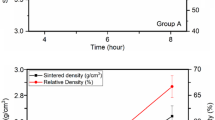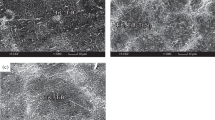Abstract
The microstructure, mechanical properties and corrosion resistance of Zr-30%Ta and Zr-25%Ta-5%Ti alloy prepared by spark plasma sintering (SPS) technology were investigated. The experimental results showed that the Zr-Ta-Ti alloys made by the SPS processing have a low level of porosity with the relative density of 96%–98%. The analyses of XRD and TEM revealed that the Zr-30Ta alloy consists of α+β phase, and the Zr-25Ta-5Ti alloy belongs to the near β type alloy containing a small amount of α and ω phases. With the addition of Ti, the elastic modulus of the alloys was decreased from (99.5±7.2) GPa for Zr-30Ta alloy to (73.6±6.3) GPa for Zr-25Ta-5Ti alloy. Furthermore, it is shown that, in comparison to CP-Ti and Ti-6Al-4V alloy, the Zr-Ta-Ti alloy produced in this work offers an improved corrosion resistance due to the more stable ZrO2 and Ta2O5 generated in the passivation film on the surface of the alloys. This study demonstrates that Zr-Ta-Ti alloys are a promising candidate of novel metallic biomaterials.
摘要
本文研究了采用放电等离子烧结(SPS)技术制备的Zr-30Ta 和Zr-25Ta-5Ti 合金的组织、力学性 能和耐蚀性。实验结果表明,采用SPS 工艺制备的Zr-Ta-Ti 合金孔隙率低,相对密度为96%~98%。 XRD 和TEM 分析表明,Zr-30Ta 合金由α+β相组成,Zr-25Ta-5Ti 合金属于近β型合金,含有少量α 和ω相。随着Ti 的加入,合金的弹性模量由(99.5±7.2) GPa (Zr-30Ta)下降到(73.6±6.3) GPa (Zr-25Ta-5Ti)。此外,与CP-Ti 和Ti-6Al-4V 合金相比,Zr-Ta-Ti 合金由于在合金表面钝化膜中生成更 稳定的ZrO2 和Ta2 O5 而具有更强的耐蚀性。以上研究表明,Zr-Ta-Ti 合金是一种很有前途的新型金属 生物材料。
Similar content being viewed by others
References
KONDO R. Microstructure and mechanical properties of as-cast Zr-Nb alloys [J]. Acta Biomaterialia, 2011, 7(12): 4278–4284. DOI: https://doi.org/10.1016/j.actbio.2011.07.020.
ZHAO X L, LI L, NIINOMI M, NAKAI M, ZHANG D L, SURYANARAYANA C. Metastable Zr-Nb alloys for spinal fixation rods with tunable Young’s modulus and low magnetic resonance susceptibility [J]. Acta Biomaterialia, 2017, 62(15): 372–384. DOI: https://doi.org/10.1016/j.actbio.2017.08.026.
ZHOU Y L, NIINOMI M, AKAHORI T. Effects of Ta content on Young’s modulus and tensile properties of binary Ti-Ta alloys for biomedical applications [J]. Materials Science and Engineering A, 2004, 371(1, 2): 283–290. DOI: https://doi.org/10.1016/j.msea.2003.12.011.
CATALANI S, STEA S, BERAUDI A, GILBERTI M E, BORDINI B, TONI A, APOSTOLI P. Vanadium release in whole blood, serum and urine of patients implanted with a titanium alloy hip prosthesis [J]. Clinical Toxicology, 2013, 51(7): 550–556. DOI: 10.3109/15563650.2013.818682.
MARECI D, BOLAT G, CAILEAN A, SANTANA J J, IZQUIERDO J, SOUTO R M. Effect of acidic fluoride solution on the corrosion resistance of ZrTi alloys for dental implant application [J]. Corrosion Science, 2014, 87(5): 334–343. DOI: https://doi.org/10.1016/j.corsci.2014.06.042.
GODLEY R, STAROSVETSKY D, GOTMAN I. Corrosion behavior of a low modulus β-Ti-45%Nb alloy for use in medical implants [J]. Journal of Materials Science-Materials in Medicine, 2006, 17(1): 63–67. DOI: https://doi.org/10.1007/s10856-006-6330-6.
MÖLLER B, TERHEYDEN H, AÇIL Y, PURCZ N M, HERTRAMPF K, TABAKOV A, BEHRENS E, WILTFANG J. A comparison of biocompatibility and osseointegration of ceramic and titanium implants: An in vivo and in vitro study [J]. International Journal of Oral & Maxillofacial Surgery, 2012, 41(5): 638–645. DOI: https://doi.org/10.1016/j.ijom.2012.02.004.
ZHOU F, WANG B, QIU K, LIN W, LI L, WANG Y B, NIE F. Microstructure, corrosion behavior and cytotoxicity of Zr-Nb alloys for biomedical application [J]. Materials Science and Engineering C, 2012, 32(4): 851–857. DOI: https://doi.org/10.1016/j.msec.2012.02.002.
CORREA D R N, VICENTE F B, DONATO TAG, ARANA-CHAVEZ V E, BUZALAF M A R, Grandini C R. The effect of the solute on the structure, selected mechanical properties, and biocompatibility of Ti-Zr system alloys for dental applications [J]. Materials Science and Engineering C, 2014, 34(1): 354–359. DOI: https://doi.org/10.1016/j.msec.2013.09.032.
JHA S K, KESKAR N, VISHNU NARAYAN K I, MANI KRISHNA K V, SRIVASTAVA D, DEY G K, SAIBABA N. Microstructural and textural evolution during hot deformation of dilute Zr-Sn alloy [J]. Journal of Nuclear Materials, 2016, 482: 12–18. DOI: https://doi.org/10.1016/j.jnucmat.2016.09.028.
SUYALAT U, RYOTA K, YUSUKE T, HISASHI D, NAOYUKI N, TAKAO H. Effects of phase constitution on magnetic susceptibility and mechanical properties of Zr-rich Zr-Mo alloys [J]. Acta Biomaterialia, 2011, 7(12): 4259–4266. DOI: https://doi.org/10.1016/j.actbio.2011.07.005.
CAI S, DAYMOND M R, KHAN A K, HOLT R A, OLIVER E C. Elastic and plastic properties of β-Zr at room temperature [J]. Journal of Nuclear Materials, 2009, 393(1): 67–76. DOI: https://doi.org/10.1016/j.jnucmat.2009.05.007.
LIU J, CHANG L, LIU H, LI Y, YANG H, RUAN J. Microstructure, mechanical behavior and biocompatibility of powder metallurgy Nb-Ti-Ta alloys as biomedical material [J]. Materials Science and Engineering C, 2017, 71: 512–519. DOI: https://doi.org/10.1016/j.msec.2016.10.043.
BRANZOI I V, IORDOC M, CODESCU M. Electrochemical studies on the stability and corrosion resistance of new zirconium-based alloys for biomedical applications [J]. Surface and Interface Analysis, 2008, 40(3, 4): 167–173. DOI: https://doi.org/10.1002/sia.2750.
BALLA V K, BODHAK S, BOSE S, BANDYOPADHYAY A. Porous tantalum structures for bone implants: fabrication, mechanical and in vitro biological properties [J]. Acta Biomaterialia, 2010, 6(8): 3349–3359. DOI: https://doi.org/10.1016/j.actbio.2010.01.046.
MEREIB D, SEU U C C, ZAKHOUR M, NAKHL M, JEAN-FRANCOIS S. Fabrication of biomimetic titanium laminated material using flakes powder metallurgy [J]. Journal of Materials Science, 2018, 53(5866): 1–12. DOI: https://doi.org/10.1007/s10853-018-2086-x.
CHANG L, LIU J, YANG H, RUAN J. Effects of Zr contents on the microstructure, mechanical properties and biocompatibility of Ta-Zr alloys [J]. Materials Science Forum, 2018, 914: 37–44. DOI: https://doi.org/10.1016/j.matdes.2018.107555.
BAYODE B L, LETHABANE M L, OLUBAMBI P A, SIGALAS I, SHONGWE M B, RAMAKOKOVHU M M. Densification and micro-structural characteristics of spark plasma sintered Ti-Zr-Ta powders [J]. Powder Technology, 2017, 321: 471–478. DOI: https://doi.org/10.1016/j.powtec.2017.08.031.
HENRIQUES V A R, SILVA C R M. Production of titanium alloys for medical implants by powder metallurgy [J]. Key Engineering Materials, 2001, 189–191: 443–448. DOI: https://doi.org/10.4028/u]www.scientific.net/KEM.189-191.443.
CHAIM R. Densification mechanisms in spark plasma sintering of nanocrystalline ceramics [J]. Materials Science and Engineering A, 2007, 443: 25–32. DOI: https://doi.org/10.1016/j.msea.2006.07.092.
LIU H W, BISHOP D P, PLUCKNETT K P. Densification behaviour and microstructural evolution of Ti-48Al consolidated by spark plasma sintering [J]. Journal of Materials Science, 2017, 52(1): 613–627. DOI: https://doi.org/10.1007/s10853-016-0358-x.
OLIVEIRA N T C, BIAGGIO S R, NASCENTE P A P, ROCHA-FILHO R C, BOCCHI N. Investigation of passive films grown on biocompatible Ti-50Zr and Ti-13Zr-13Nb alloys by XPS [J]. Surface and Interface Analysis, 2006, 38(4): 410–412. DOI: https://doi.org/10.1002/sia.2201.
MILSOEV, ZERJAV G, CALDERON MORENO J M, MONICA P. Electrochemical properties, chemical composition and thickness of passive film formed on novel Ti-20Nb-10Zr-5Ta alloy [J]. Electrochimica Acta, 2013, 99(3): 176–189. DOI: https://doi.org/10.1016/j.electacta.2013.03.086.
PAN J, THIERRY D, LEYGRAF C. Electrochemical impedance spectroscopy study of the passive oxide film on titanium for implant application [J]. Electrochimica Acta, 1996, 41(7): 1143–1153. DOI: https://doi.org/10.1016/0013-4686(95)00465-3.
DAI N, ZHANG L, ZHANG J, ZHANG X, NIE Q, CHEN Y, WU M, CHAO Y. Distinction in corrosion resistance of selective laser melted Ti-6Al-4V alloy on different planes [J]. Corrosion Science, 2016, 111: 703–710. DOI: https://doi.org/10.1016/j.corsci.2016.06.009.
JONÁSOVÁL, MÜLLER F A, HELEBRANT A, STRNAD J, GREIL P. Biomimetic apatite formation on chemically treated titanium [J]. Biomaterials, 2004, 25(7): 1187–1194. DOI: https://doi.org/10.1016/j.biomaterials.2003.08.009.
GUO W, SUN J, WU J. Electrochemical and XPS studies of corrosion behavior of Ti-23Nb-0.7Ta-2Zr-O alloy in Ringer’s solution [J]. Materials Chemistry and Physics, 2009, 113(2,3): 816–820. DOI: https://doi.org/10.1016/j.matchemphys.2008.08.043.
LIN J, OZAN S, MUNIR K, WANG K, TONG X, LIY, LI G, WEN C. Effects of solution treatment and aging on the microstructure, mechanical properties, and corrosion resistance of a β type Ti-Ta-Hf-Zr alloy [J]. RSC Advances, 2017, 7(20): 12309–12317. DOI: https://doi.org/10.1039/c6ra28464g.
MORENO J M C, VASILESCU E, DROB P, OSICEANU P, VASILESCU C, DROB S I, POPA M. Surface and electrochemical characterization of a new ternary titanium based alloy behaviour in electrolytes of varying pH [J]. Corrosion Science, 2013, 77(12): 52–63. DOI: https://doi.org/10.1016/j.corsci.2013.07.026.
HSIUNG L M, LASSILA D H. Shock-induced deformation twinning and omega transformation in tantalum and tantalum-tungsten alloys [J]. Acta Materialia, 2000, 48(20): 4851–4865. DOI: https://doi.org/10.1016/s1359-6454(00)00287-1.
DEY G K, TEWARQI R, BANERJEE S, JYOTI G, GUPTA S C, JOSHI K D, SIKKA S K. Formation of a shock deformation induced ω phase in Zr20Nb alloy [J]. Acta Materialia, 2004, 52(18): 5243–5254. DOI: https://doi.org/10.1016/j.actamat.2004.07.008.
YEDDU H K, LOOKMAN T, SAXENA A. The simultaneous occurrence of martensitic transformation and reversion of martensite [J]. Materials Science and Engineering A, 2014, 594(594): 48–51. DOI: https://doi.org/10.1016/j.msea.2013.11.036.
ZHANAL P, HARCUBA P, HÁJEK M, SMOLA B, STRASKY J, SMILAUEROVA J, VESELY J, JANECEK M. Evolution of to phase during heating of metastable β titanium alloy Ti-15Mo [J]. Journal of Materials Science, 2018, 53(1): 837–845. DOI: https://doi.org/10.1007/s10853-017-1519-2.
HAO Y L, YANG R, NIINOMI M, KURODA D, ZHOU Y L, FUKUNAGA K, SUZUKI A. Aging response of the Young’s modulus and mechanical properties of Ti-29Nb-13Ta-4.6Zr for biomedical applications [J]. Metallurgical and Materials Transaction-Springer A, 2003, 34(4): 1007–1012. DOI: https://doi.org/10.1007/s11661-003-0230-x.
WANG B, RUAN W, LIU J, ZHANG T, YANG H, RUAN J. Microstructure, mechanical properties, and preliminary biocompatibility evaluation of binary Ti-Zr alloys for dental application [J]. Journal of Biomaterials Applications, 2018, 33(6): 766–775. DOI: https://doi.org/10.1177/0885328218811052.
MURRAY J L. The Ti-Zr (titanium-zirconium) system [J]. Bulletin of Alloy Phase Diagrams, 1981, 2: 197–201. DOI: https://doi.org/10.1007/BF02881478.39.
ASSIS S L, COSTA I. Electrochemical evaluation of Ti-13Nb-13Zr, Ti-6Al-4V and Ti-6Al-7Nb alloys for biomedical application by long-term immersion tests [J]. Materials and Corrosion, 2015, 58(5): 329–333. DOI: https://doi.org/10.1002/maco.200604027
YU Z. Evalution of haemocompatibility of TLM titaniun alloy with surfance herpairnization [J]. Rare Metal Materials and Engineering, 2009, 38(3): 932.
CORNE P, MARCH P D, CLEYMAND F, GERINGER J. Fretting-corrosion behavior on dental implant connection in human saliva [J]. Journal of the Mechanical Behavior of Biomedical Materials, 2019, 94: 86–92. DOI: https://doi.org/10.1016/j.jmbbm.2019.02.025.
NIE L, ZHAN Y, HU T, CHEN X, WANG C. β-type Zr-Nb-Ti biomedical materials with high plasticity and low modulus for hard tissue replacements [J]. Journal of the Mechanical Behavior Materials, 2014, 29: 1–6. DOI: https://doi.org/10.1016/j.jmbbm.2013.08.019.
KONDO R, NOMURA N, SUYALATU, TSUT SUMI Y, DOI H, HANAWA T. Microstructure and mechanical properties of as-cast Zr-Nb alloys [J]. Acta Biomaterials 2011, 7(12): 4278–4284. DOI: https://doi.org/10.1016/j.actbio.2011.07.020.
ZHOU Y L, NIINOMI M, AKAHORIT, FUKUI H, TODA H. Corrosion resistance and biocompatibility of Ti-Ta alloys for biomedical applications [J]. Materials Science and Engineering A, 2005, 398(1): 28–36. DOI: https://doi.org/10.1016/j.surfcoat.2005.04.044
BOLAT G, IZQUIERDO J, SANTANA J J, MARECI D, SOUTO R M. Electrochemical characterization of ZrTi alloys for biomedical applications [J]. Electrochimica Acta, 2013, 106: 432–439. DOI: https://doi.org/10.1016/j.electacta.2012.10.026.
Author information
Authors and Affiliations
Corresponding authors
Additional information
Foundation item: Project(51404302) supported by the National Natural Science Foundation of China; Project(QJ2018003A) supported by the Youth Scientific Research Foundation of the Central South University of Forestry and Technology, China
Rights and permissions
About this article
Cite this article
Xue, Gl., Yang, Hl., Xing, Hx. et al. Effect of Ti on microstructure, mechanical properties and corrosion resistance of Zr-Ta-Ti alloys processed by spark plasma sintering. J. Cent. South Univ. 27, 2185–2197 (2020). https://doi.org/10.1007/s11771-020-4440-9
Received:
Accepted:
Published:
Issue Date:
DOI: https://doi.org/10.1007/s11771-020-4440-9




